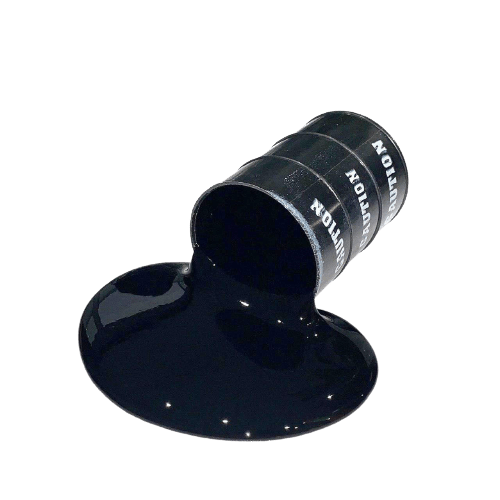Bitumen
Bitumen is a hydrocarbon black to dark brown in color that dissolves completely in carbon sulfide and carbon tetrachloride. Bitumen is solid at ambient temperature. But as the temperature rises, it becomes a paste and then liquefies.
Types of bitumen
Bitumens are usually divided into three general categories according to their origin:
1- Natural bitumen
2 -Oil bitumen
3 – Qatari bitumen
Natural bitumens are the same as surface crude oils, whose light components have evaporated over time and taken on the shape of bitumen due to the abrasion, and its source is crude oil
Petroleum bitumen in the refinery is obtained from the distillation of crude oil. In the refinery, crude oil is first heated in a furnace under ambient pressure with a temperature of 150-100 ° C before entering the tower
a-Pure bitumen
b- Blowed bitumen: This type of bitumen is produced by blowing method
c- Bitumen emulsion: Types of emulsion bitumen including fast breaking bitumen emulsions, slow breaking bitumen emulsions and slow breaking bitumen emulsions
Bituminous emulsion breaker
Unstable bituminous emulsion breakers break down very quickly on the surface of the material, leaving a very thin layer of bitumen. Their main uses are in sealing with stone materials, sealing with sand, surface asphalts and penetrating macadam. Accelerating emulsion bitumen have a high mental slowness in order not to flow on the road surface
Bitumen emulsion breaker
This category includes bitumen-emulsion breakers, which are more stable than fast-breaking emulsions and can be mixed with heavy materials. Because they do not break immediately after contact with the aggregates and the asphalt composition maintains its efficiency for a few minutes. Slurry emulsion bitumen gives a better coating to stone materials at high ambient temperatures
Refractory bitumen emulsion
This category includes bitumen emulsion crushers that have a very high stability after contact with stone materials. Bitumen emulsion has a low psychological breakdown, which can be further reduced by adding water. When diluted, this group can be used for surface coating, pavement sealing without aggregate consumption and dust suppression
d- Soluble bitumens: Types of soluble bitumens include SC retarder, MC medium attenuator and RC quick retainer. Soluble bitumen or cutback which is a combination of bitumen and petroleum solvent. The oil solvent reduces the viscosity of the bitumen and thus appears as a solution. Soluble bitumen due to lower viscosity than bitumen can be used at ambient temperature and is cold run due to the looseness of this type of bitumen has a very good penetration. Soluble bitumens were commonly used as asphalt coatings and substrates. It works to protect asphalt against cold and hot weather
Bitumen Cutback Delay SC SC70 SC250 SC800 SC3000
This type of bitumen is obtained by dissolving 100/85 bitumen in heavy solvents such as diesel or fuel, where the solvent evaporates at a low rate and causes the bitumen to harden. Types of this type of bitumen include SC SC70 SC250 SC800 SC3000
Moderate bitumen cut bitumen MC30 MC70 MC250 MC800 MC3000 MC
Medium soluble bitumen is produced by dissolving bitumen in kerosene, which evaporates more slowly than gasoline. Medium soluble bitumen is divided into five groups whose viscosity varies between 3-4 and 6000 at 60 ° C. This type of bitumen may be obtained by dissolving 85/100 bitumen in kerosene. These types of bitumen include MC30 MC70 MC250 MC800 MC3000 MC
Quick bitumen cutback RC RC250 RC70 RC800 RC3000
If bitumen dissolves in gasoline, cutback bitumen is known as RC. The reason for this is that evaporation occurs quickly and bitumen precipitates. RC sections are divided into RC250, RC70, RC800 and RC3000 categories. The numbers indicate the viscosity of the bitumen. To further dilute, naphtha can be mixed with 80/100 bitumen
Tar bitumen
This type of bitumen is used in places where there is a possibility of spillage of solvent or fuel due to its longer durability and ineffectiveness of solvents.
a- Road Tar
b- Moldy charcoal dust
c- Charcoal electrodes
d- Glaze and coating of pipes
In general, Iranian bitumen is exported in three types of packaging: barrels, bulk and bags, and both by land and sea. Bulk bitumen is exported by land by bulk carriers by sea and by tankers, and barrel and bag bitumen are sold by sea to land to destination countries via container and land.
Export price of bitumen:
It is difficult to predict the price of bitumen for export in recent years. This is because there are several factors involved in determining the price of export bitumen. One of the influential factors in the price of bitumen is the amount of production and demand for this material. As you know, most export goods, especially oil and petroleum products, are bought and sold in world markets using dollars.
Another factor affecting the export price of bitumen is the transportation costs of bitumen. However, the most important factor influencing the price of bitumen is the world price of oil. Which has a significant effect on the price of bitumen. Because as the price of crude oil rises, so does the price of its products. And as crude oil prices fall, so do the prices of its products
Some major destinations for bitumen exports from Iran:
India, UAE, Bangladesh, Kenya, Oman, Iraq and China and Taiwan and Qatar and…





